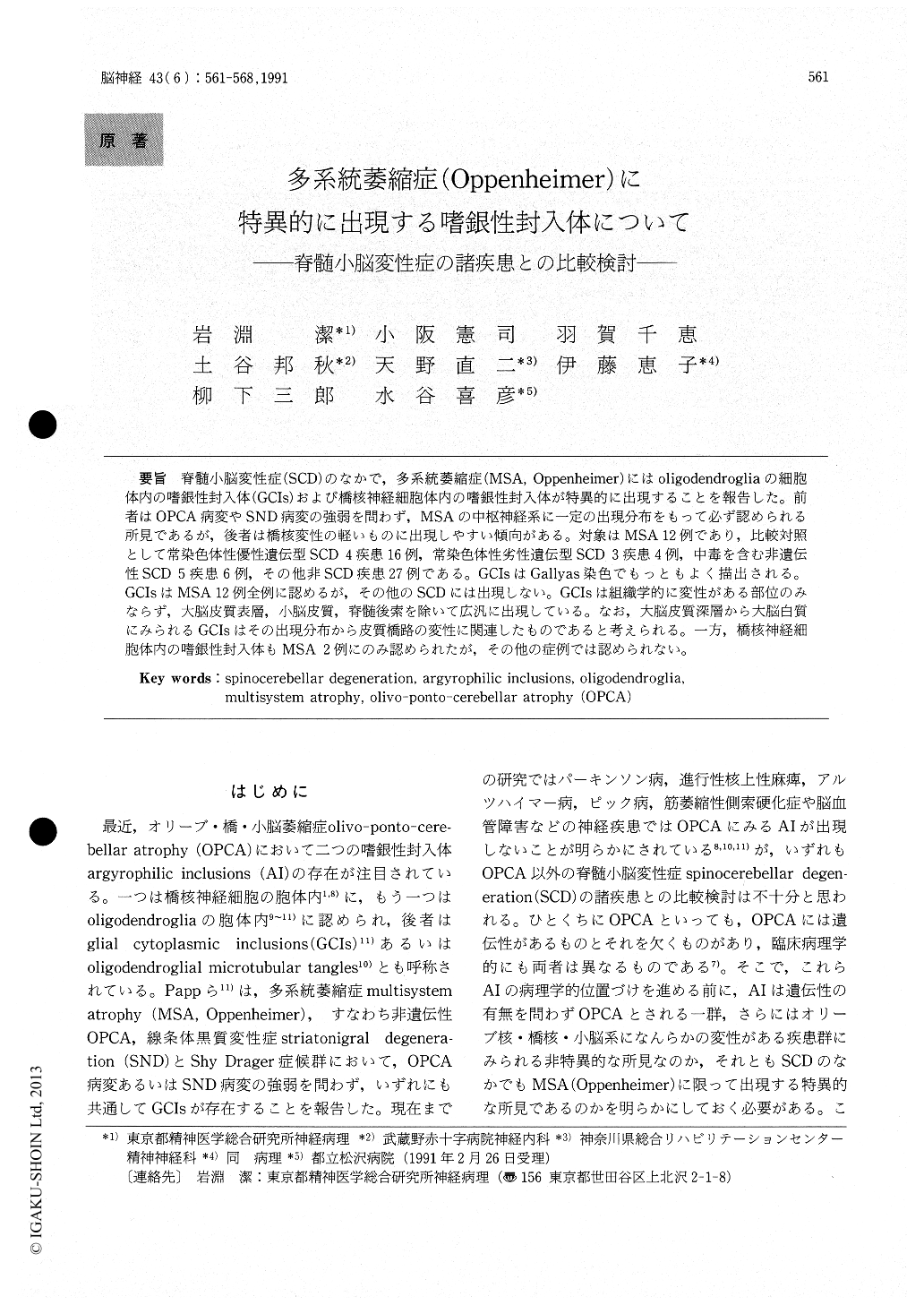Japanese
English
- 有料閲覧
- Abstract 文献概要
- 1ページ目 Look Inside
脊髄小脳変性症(SCD)のなかで,多系統萎縮症(MSA, Oppenheimer)にはoligodendrogliaの細胞体内の嗜銀性封入体(GCIs)および橋核神経細胞体内の嗜銀性封入体が特異的に出現することを報告した。前者はOPCA病変やSND病変の強弱を問わず,MSAの中枢神経系に一定の出現分布をもって必ず認められる所見であるが,後者は橋核変性の軽いものに出現しやすい傾向がある。対象はMSA 12例であり,比較対照として常染色体性優性遺伝型SCD 4疾患16例,常染色体性劣性遺伝型SCD 3疾患4例,中毒を含む非遺伝性SCD 5疾患6例,その他非SCD疾患27例である。GCIsはGallyas染色でもっともよく描出される。GCIsはMSA 12例全例に認めるが,その他のSCDには出現しない。GCIsは組織学的に変性がある部位のみならず,大脳皮質表層,小脳皮質,脊髄後索を除いて広汎に出現している。なお,大脳皮質深層から大脳白質にみられるGCIsはその出現分布から皮質橋路の変性に関連したものであると考えられる。一方,橋核神経細胞体内の嗜銀性封入体もMSA 2例にのみ認められたが,その他の症例では認められない。
Non-hereditary olivo-ponto-cerebellar atrophy(OPCA) and striato-nigral degeneration (SND) have been looked upon as a single disease entity called multisystem atrophy (MSA) by Oppen-heimer. This study revealed that both intracytoplas-mic argyrophilic inclusions (AI) in pontine neurons and glial (argyrophilic) cytoplasmic inclusions (GCIs) widely distributed in the CNS are characte-ristics of MSA.
Materials : a) 12 cases with MSA, b) 16 cases with autosomal dominant (AD) form of spinocere-bellar degeneration (SCD) : AD form of OPCA 5 cases, Joseph disease 4 cases, AD-dentatorubro-pallidoluysian atrophy (Naitoh & Oyanagi's form) 6 cases, AD-spastic ataxia (Brown) 1 case, c) 4 cases with autosomal recessive (AR) form of SCD : AR form of OPCA 1 case, myoclonic epilepsy with ragged-red fibers (MERRF) 1 case, complicated form of spastic paraplegia 2 cases, d) 6 cases with non-hereditary SCD including intoxications : late cortical cerebellar atrophy 1 case, alcoholic cerebel-lar degeneration 2 cases, phenytoin-induced cerebel-lar degeneration 1 case, neuroleptic malignant syn-drome 1 case, and e) 27 cases with other neuropsy-chiatric diseases : Alzheimer disease 20 cases, pro-gressive supranuclear palsy 5 cases, schizophrenia 2 cases.
Method : We examined 10 μ-thick paraffin sec-tions stained with HE, Kluver-Barrera, Bodian, Holzer, Gallyas, and Bielschowski methods.
Results : AI in pontine neurons were found only in two cases of MSA. Interestingly no AI could be detected even in cases with AD form of OPCA showing mild degeneration in the pontocerebellar system. On the other hand, GCIs were found in all cases with MSA irrespective of the degree of degen-eration in the olivo-ponto-cerebellar or striato-nigral system. However, there was no GCIs in cases with other form of SCD and other neuropsychiatric diseases. Gallyas stain was the best method for detecting GCIs. GCIs were widely distributed in the CNS except for superficial layers of the cerebral cortex, the cerebellar cortex, and the dorsal colum of the spinal cord. There were also many GCIs in the putamen, pontine base, and cerebellar white matter, even though these sites were well preserved.

Copyright © 1991, Igaku-Shoin Ltd. All rights reserved.


